Citizen Science Provides an Efficient Method for Broad-Scale Tick-Borne Pathogen Surveillance of Ixodes pacificus and Ixodes scapularis across the United States
- PMID: 34585963
- PMCID: PMC8550138
- DOI: 10.1128/mSphere.00682-21
Citizen Science Provides an Efficient Method for Broad-Scale Tick-Borne Pathogen Surveillance of Ixodes pacificus and Ixodes scapularis across the United States
Abstract
Tick-borne diseases have expanded over the last 2 decades as a result of shifts in tick and pathogen distributions. These shifts have significantly increased the need for accurate portrayal of real-time pathogen distributions and prevalence in hopes of stemming increases in human morbidity. Traditionally, pathogen distribution and prevalence have been monitored through case reports or scientific collections of ticks or reservoir hosts, both of which have challenges that impact the extent, availability, and accuracy of these data. Citizen science tick collections and testing campaigns supplement these data and provide timely estimates of pathogen prevalence and distributions to help characterize and understand tick-borne disease threats to communities. We utilized our national citizen science tick collection and testing program to describe the distribution and prevalence of four Ixodes-borne pathogens, Borrelia burgdorferi sensu lato, Borrelia miyamotoi, Anaplasma phagocytophilum, and Babesia microti, across the continental United States. IMPORTANCE In the 21st century, zoonotic pathogens continue to emerge, while previously discovered pathogens continue to have changes within their distribution and prevalence. Monitoring these pathogens is resource intensive, requiring both field and laboratory support; thus, data sets are often limited within their spatial and temporal extents. Citizen science collections provide a method to harness the general public to collect samples, enabling real-time monitoring of pathogen distribution and prevalence.
Keywords: Anaplasma phagocytophilum; Babesia microti; Borrelia; Borrelia burgdorferi; Borrelia miyamotoi; Lyme disease; anaplasmosis; babesiosis; relapsing fever; tick-borne.
Figures
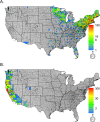

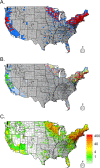
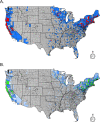
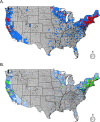
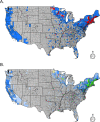
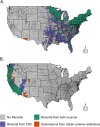

Similar articles
-
Relatively low prevalence of Babesia microti and Anaplasma phagocytophilum in Ixodes scapularis ticks collected in the Lehigh Valley region of eastern Pennsylvania.Ticks Tick Borne Dis. 2015 Sep;6(6):812-9. doi: 10.1016/j.ttbdis.2015.07.009. Epub 2015 Aug 5. Ticks Tick Borne Dis. 2015. PMID: 26318263
-
Spatial and temporal distribution of Ixodes scapularis and tick-borne pathogens across the northeastern United States.Parasit Vectors. 2024 Nov 22;17(1):481. doi: 10.1186/s13071-024-06518-9. Parasit Vectors. 2024. PMID: 39574137 Free PMC article.
-
Pathogen transmission in relation to duration of attachment by Ixodes scapularis ticks.Ticks Tick Borne Dis. 2018 Mar;9(3):535-542. doi: 10.1016/j.ttbdis.2018.01.002. Epub 2018 Jan 31. Ticks Tick Borne Dis. 2018. PMID: 29398603 Free PMC article. Review.
-
Prevalence of five human pathogens in host-seeking Ixodes scapularis and Ixodes pacificus by region, state, and county in the contiguous United States generated through national tick surveillance.Ticks Tick Borne Dis. 2023 Nov;14(6):102250. doi: 10.1016/j.ttbdis.2023.102250. Epub 2023 Sep 11. Ticks Tick Borne Dis. 2023. PMID: 37703795 Free PMC article.
-
The Blacklegged Tick, Ixodes scapularis: An Increasing Public Health Concern.Trends Parasitol. 2018 Apr;34(4):295-309. doi: 10.1016/j.pt.2017.12.006. Epub 2018 Jan 11. Trends Parasitol. 2018. PMID: 29336985 Free PMC article. Review.
Cited by
-
Predicting distributions of blacklegged ticks (Ixodes scapularis), Lyme disease spirochetes (Borrelia burgdorferi sensu stricto) and human Lyme disease cases in the eastern United States.Ticks Tick Borne Dis. 2022 Sep;13(5):102000. doi: 10.1016/j.ttbdis.2022.102000. Epub 2022 Jun 30. Ticks Tick Borne Dis. 2022. PMID: 35785605 Free PMC article.
-
Development of a Community-Driven Mosquito Surveillance Program for Vectors of La Crosse Virus to Educate, Inform, and Empower a Community.Insects. 2022 Feb 3;13(2):164. doi: 10.3390/insects13020164. Insects. 2022. PMID: 35206737 Free PMC article.
-
Northward Expansion of Amblyomma americanum (Acari: Ixodidae) into Southwestern Michigan.J Med Entomol. 2022 Sep 14;59(5):1646-1659. doi: 10.1093/jme/tjac082. J Med Entomol. 2022. PMID: 35776508 Free PMC article.
-
Environmental variables serve as predictors of the invasive Asian longhorned tick (Haemaphysalis longicornis Neumann): An approach for targeted tick surveillance.PLoS One. 2023 Nov 2;18(11):e0292595. doi: 10.1371/journal.pone.0292595. eCollection 2023. PLoS One. 2023. PMID: 37917728 Free PMC article.
-
Detection of Borrelia burgdorferi sensu lato species in host-seeking Ixodes species ticks in the United States.Ticks Tick Borne Dis. 2024 Jan;15(1):102270. doi: 10.1016/j.ttbdis.2023.102270. Epub 2023 Oct 7. Ticks Tick Borne Dis. 2024. PMID: 37813001 Free PMC article.
References
-
- Diuk-Wasser MA, Hoen AG, Cislo P, Brinkerhoff R, Hamer SA, Rowland M, Cortinas R, Vourc’h G, Melton F, Hickling GJ, Tsao JI, Bunikis J, Barbour AG, Kitron U, Piesman J, Fish D. 2012. Human risk of infection with Borrelia burgdorferi, the Lyme disease agent, in Eastern United States. Am J Trop Med Hyg 86:320–327. doi:10.4269/ajtmh.2012.11-0395. - DOI - PMC - PubMed
-
- Gatewood AG, Liebman KA, Vourc’h G, Bunikis J, Hamer SA, Cortinas R, Melton F, Cislo P, Kitron U, Tsao J, Barbour AG, Fish D, Diuk-Wasser MA. 2009. Climate and tick seasonality are predictors of Borrelia burgdorferi genotype distribution. Appl Environ Microbiol 75:2476–2483. doi:10.1128/AEM.02633-08. - DOI - PMC - PubMed
-
- Fleshman AC, Graham CB, Maes SE, Foster E, Eisen RJ. 2021. Reported county-level distribution of Lyme disease spirochetes, Borrelia burgdorferi sensu stricto and Borrelia mayonii (Spirochaetales: Spirochaetaceae), in host-seeking Ixodes scapularis and Ixodes pacificus ticks (Acari: Ixodidae) in the contiguous United States. J Med Entomol 58:1219–1233. doi:10.1093/jme/tjaa283. - DOI - PMC - PubMed
Publication types
MeSH terms
Supplementary concepts
LinkOut - more resources
Full Text Sources
Molecular Biology Databases
